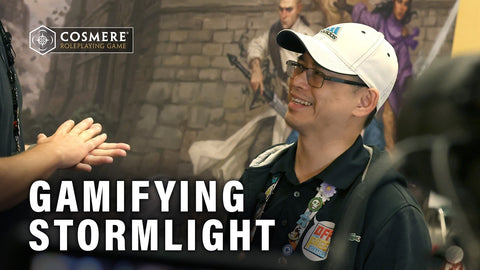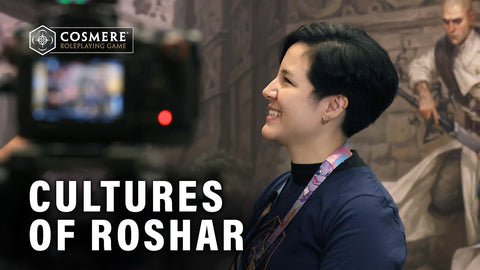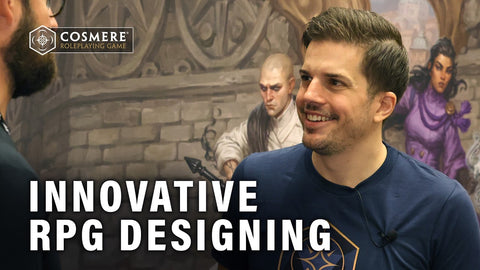The following interview includes paraphrased questions and answers to make it easy to scan through. These are not meant to be taken as direct quotes.
Q: Can you tell us about your journey to becoming a writer and designer for the Stormlight RPG?
Sen-Foong Lim: I started as a board game designer, working on titles like Batman and Scooby-Doo. Johnny reached out to me with a hush-hush project and asked what I thought of Brandon Sanderson’s work. I knew right away this was going to be something special—something that would make history. The project does an incredible job reflecting Brandon’s stories and bringing them to life in a new medium.
Q: What was it like adapting Brandon’s work into an RPG, especially with creatures, magic, and fabrials?
Sen-Foong Lim: Adapting Brandon’s world into an RPG involved taking all the knowledge from the books and figuring out how to mechanize it in a way that made sense for gameplay. I was mostly responsible for creating the fabrials. While there’s a lot of lore on them, we don’t know the exact process. After working with Johnny, the team, and Brandon, we figured out not only how to incorporate fabrials but also how to create them. It’s something new that fans haven’t seen before. We wanted to make sure that even if something doesn’t exist in the books yet, the process to create it feels authentic and canonical.
Q: Were there any surprises when working on fabrials?
Sen-Foong Lim: What surprised me the most was how deeply people love Brandon’s writing and how much theory crafting goes into it. I was nervous about breaking people’s headcanons—it’s a real risk when working on something like this. But we embraced the gray areas of the lore, exploring what happens when things go wrong, like cutting a gem incorrectly. It’s a delicate balance between sticking to the source material and leaving room for players to tell their own stories.
Q: How does the RPG appeal to fans of TTRPGs who may not be familiar with the Cosmere?
Sen-Foong Lim: One of the great things about Roshar is the representation. As a person of color, it’s important to see that reflected in a lived-in world like Roshar. The Radiants are different from typical power fantasies—they do things for reasons like justice or remembering the forgotten. This game encourages players to think about what it means to have power and how to use it responsibly. I think players will also find the Singers’ perspective fascinating, even if they’re not familiar with the books.
Q: Brandon’s writing often includes allegory. How did that influence the writing team?
Sen-Foong Lim: Exploring another culture from an outsider’s point of view is a powerful experience. Brandon’s world is filled with things that may seem strange at first, like why men don’t read or why women keep a safe hand. But as you dig deeper, you start to question your own culture and norms. Good literature, and by extension this RPG, forces us to look at ourselves. Why can’t I be a Radiant in real life? Why can’t I enforce truth or ensure people remember the forgotten? These are important questions that we wanted to reflect in the game.
Q: For players who enjoy power fantasies, how does the game satisfy that itch?
Sen-Foong Lim: If you ever get a Shardblade, you’ve won, haha! But beyond that, the game really is an empathy engine, just like Brandon’s books. It compels you to dig deeper—why do Radiants get certain powers, and why should you play a non-Radiant character? Even if you’re not the most powerful character, like Batman in the Justice League, you can still be meaningful to the story. We’ve built a lot into the system to make sure characters who aren’t Radiants still have a rich and impactful experience.
Q: Why would someone choose not to be a Radiant in the game?
Sen-Foong Lim: If everyone is a Radiant, the game escalates in one way, but you lose the depth of character variety. Characters like the Ghostbloods aren’t Radiants, but they’re still incredibly interesting. The journey to becoming a Radiant—or choosing not to—can be just as compelling as wielding a Shardblade. That intrigue and character development are more important than raw power.
Q: Is there a specific mechanic in the game that isn’t getting enough attention?
Sen-Foong Lim: Meric and I are working on something special—a first-step adventure designed to bring in players who aren’t into the crunchiness of role-playing. It’s like a choose-your-own-adventure game that introduces mechanics as you go. By the end of the session, which lasts about two or three hours, you’ll have a fully developed character without needing to read any rulebooks. It’s a gamified tutorial that makes it easy for newcomers to jump in.
Q: How does the Plot Die enhance storytelling in the game?
Sen-Foong Lim: The Plot Die is a unique mechanic that allows players to raise the stakes in the story. It’s weighted to create moments where you succeed but with a consequence, or fail but with an opportunity. This adds gravitas to the sessions and makes the story feel more dynamic. It’s like in Brandon’s books—characters experience highs and lows, and the Plot Die helps replicate that emotional journey in the game.
Q: How do you ensure the game remains engaging for both Radiants and non-Radiants?
Sen-Foong Lim: The game is designed to give both Radiants and non-Radiants meaningful roles. Even if a character isn’t taking on a Chasmfiend, they can still have an interesting story arc. The opportunity to grow into a Radiant, or to live most of the game as a non-Radiant and then become one, adds depth. The key is that intrigue and character development are more important than simply dealing damage.




Comments (0)
There are no comments for this article. Be the first one to leave a message!